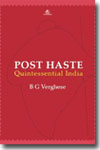|
Home |
Damn It All: Imagination Runs RiotAmong imagined downstream impacts of cumulative dams are rivers running dry in the lean season and monsoon deluges following openings of floodgates. By B G Verghese New Indian Express, 11 October, 2010 Flights of fancy and mounting electoral competition in the run up to the 2011 Assam polls are in danger of distorting development and social realities in the Northeast. Assamese and Arunachali apprehensions are being pumped up on the basis of reports of the 140-168 MOUs signed by Arunachal with public sector and private hydro-power companies to exploit the huge-power potential of the Brahmaputra basin. AASU, AGP and sundry other NGOs and activists are in the fray. Earlier, the cry was ‘Stop Tipaimukh’. The prime focus of the agitation is the National Thermal Power Corporation’s 2000 MW Lower Subansiri Project (LSP), a component of the cascade approved in 2004 by the Supreme Court (barring any storage dams upstream of this terminal structure on the Subansiri) after many years of litigation. The Court imposed a substantial burden on the project for eco-protection, a nature park, consequential secondary displacement, resultant compensation and R&R. Now that the dam is rising, the stop-LSP and wider anti-dam campaign has got more shrill, and a barge carrying a project turbine has been impounded by protestors at Tezpur, and an Arunachal blockade threatened. Among imagined downstream impacts of cumulative dams are rivers running dry in the lean season and monsoon deluges following openings of floodgates. Worse is forecast following a dam break, such as of the LSP which straddles a fault in this highly seismic zone. The fact is that the MOUs mostly relate to modest-sized projects, largely run-of-river schemes with small diurnal pondages for generating peaking power. The basic premise is therefore greatly exaggerated. High Himalayan seismicity has been factored into dam designs, incorporating defensive measures at additional cost to ensure dam safety. This was minutely examined decades back in regard to the Tehri Dam (and more recently in respect of Tipaimukh). The prophets of doom have been proven wrong with the nearby Maneri Bhali dam on the Bhagirathi surviving the great Uttarkashi earthquake without a scratch, despite the epicentre being in very close proximity to that structure, while adjacent buildings crumbled. Fears of reservoir-induced seismicity (RIS) in the Himalaya are also technically unfounded. The notion that dams reduce summer flows and induce monsoonal flooding is similarly misplaced. RoR projects have no impact on flows either way. Stored waters passing through a turbine will actually augment lean season flows, with benefits to fisheries, ecology and navigation. Conversely, impoundment behind storages like LSP could moderate floods and reduce their residence time. The opening of flood gates when a reservoir is full would merely release the quantum of water that would in any case have flowed down the river. Assam’s fatal problem is lack of storages in Arunachal and dependence on failing embankments that have aggravated flooding by impeding drainage and raising bed levels. Assam’s studied failure to encourage storages over the past many decades is truly astonishing considering the devastating floods it suffers annually with grievous loss of life, livelihood, livestock, property and infrastructure. Floods and inadequate power keep Assam poor, depress its agriculture and deny its people incomes, employment and opportunity that should be theirs. Arunachal too has taken a narrow view of its long term interests by opting overwhelmingly for RoR projects. Submergence could be limited to a few strategic upstream storages that would enhance cascading benefits in all downstream schemes with rather modest displacement in sparsely populated valleys. The notion that Arunachal only needs limited power is fallacious. “Surplus” power could be converted into goods and services in mutually agreed special inter-state processing zones located within disputed areas along the border with Assam. The 12 per cent power royalty given to the host state would allow plough back of soaring revenues for social benefit in addition to investment of the further one per cent power royalty now mandated for local community development around project sites. Besides, the very construction of each project would entail wider area development on both sides of the border and open up upper valleys through connectivity, market access, horticultural and tourism opportunities, education, health and other basic services. Arunachal could become a South Asian tiger rather than be left strategically undeveloped as hitherto as a buffer zone against China, an absurd proposition that invites trouble. Fears of losing fish runs are exaggerated and the idea of jeopardy to 0.5 to 4 million fishermen’s livelihoods in the Brahmaputra Valley fanciful. Fishing and navigation should actually improve. Concerns that the import and settlement of half a million “outside” labourers will change the demographic balance is also misconceived. Roads and other infrastructure the Northeast so keenly desires are already being built by “outside “ labour, including illicit immigrants who are moving into Arunachal and Nagaland with local connivance. The NE Vision-2020 clearly stated that the sustained 10-12 per cent growth rate necessary for the region to escape poverty and catch up with the rest of the country would necessitate importing labour and skills for some time. The safeguard lies in issuing work permits and enrolling “outsiders” in a single, general, non-territorial electoral constituency so that they influence the outcome in only one seat and not many, as in Assam. This is perfectly constitutional. Young people in the Northeast aspire to a future, maintaining what is best in tradition but embracing change. The regression and increasing erosion caused by tighter jhum cycles and the large expanse of abandoned jhums suggests growing social disinclination in persevering with what is now an unsustainable method of agro-forestry. Cooperativised smallholder plantations offer promise. Climate change has added a whole new dimension to farming, water conservation and energy planning. Non-conventional energy sources must of course be tapped. But paper calculations of a here-and-now 20,000 MW gobar gas potential that could substitute for Eastern Himalayan hydro power, as one leading dam-buster has advocated, is to trivialise understanding, the well being and even the security of the Northeast. Pity that imagination has run riot and the Union Minister for Environment and Forests has rushed to tilt with Northeastern windmills. Meanwhile, the good news from the Northeast is that the NSCN (Muivah-Swu), the NSCN (Khaplang), and Phizo’s remnant Naga Nationalist Organisation have agreed to end their fratricidal war and join hands to build peace. Internal fissures have long bled the Naga people and impeded a settlement. With the achievement of internal Naga unity the peace talks with the Government of India should now move forward. Elaborate exchanges have taken place, including exercises setting out what Naga negotiators would like included in or excluded from conjoined Indian and Naga constitutions within the bounds of practical possibilities and ground realities. The Nagas’ unique Naga identity and sense of peoplehood can be accommodated within the framework of the commonwealth that India too uniquely represents. Likewise, the Nagalim ideal could find expression in imaginative non-territorial solutions that have found place elsewhere in India. |
||
| back to the top | |||
HOME | ABOUT THE AUTHOR | LIST OF ARTICLES | CONTACT | BOOKS See also AsianConversations.com 11-C Dewan Shree Apartments, 30 Ferozeshah Rd, New Delhi 110001, India
|


